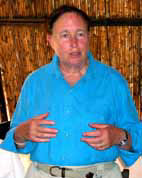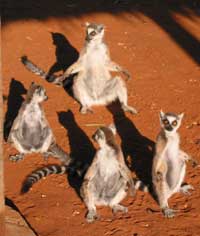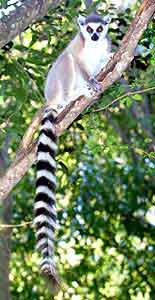|
|
|
|
|||||||
Lemurs, without too much contradiction, are the key wildlife attraction in Madagascar. In fact without the lemurs, the world's fourth largest island would have little else but bizarre botanic specimens to attract a trickle of garden lovers.
The good news is that there are a slowly growing number of preserved forests in which these ancient primates can now survive. You see, Madagascar is one of the most heavily deforested countries on earth, with over 85% of its cover removed for timber and slashed-and-burnt for agriculture. Fifteen lemur species are already extinct thanks to man and the remaining thirty-two are endangered, some critically.
The world has come to know of these highly unusual animals thanks to the exploits of an eclectic bunch of nature-loving Englishmen, primarily Sir David Attenborough, closely followed by John Cleese and the late Douglas Adams. The academic community has long been aware of the biological significance of Madagascar and it is now vigorously studied and researched. Significantly women appear to be leading in this arena with such notable authors as Dr Alison Jolly, Kathryn Lasky, Joyce A. Powzyk, Kathy Darling, Deborah Dennard and Dr Patricia Wright. The World Wildlife Fund (WWF) also has several programmes under way.
 Alison
Jolly can take most of the credit for kicking off modern study into
lemurs some forty years ago when she began visiting the Berenty Private
Reserve, 85 kms from Fort Dauphin in the island's south. As a result
of her landmark studies, Jolly opened the gates for countless other
researchers and, since the early 1980s, tourists.
Alison
Jolly can take most of the credit for kicking off modern study into
lemurs some forty years ago when she began visiting the Berenty Private
Reserve, 85 kms from Fort Dauphin in the island's south. As a result
of her landmark studies, Jolly opened the gates for countless other
researchers and, since the early 1980s, tourists.
The father of the current owner, Henri de Heaulme, established the Berenty (Big Eel) reserve in 1936 in tandem with his vast sisal plantations in the semi-arid Amboasary region. Tens of thousands of hectares of the unique dry spiny forest were cleared by de Heaulme and others to make way for the imported fibre-producing plant. But when synthetic alternatives were developed, the sisal industry all but collapsed and now only the de Heaulme plantations remain.
Did de Heaulme take pity on the homeless families of lemurs his burgeoning crops had created when left a few hundred hectares for the new refugees? In a Schindleresque sort of irony, de Heaulme's sisal empire may have saved many species by protecting them from the much less discriminating slash-and-burn techniques of the local Tandroy people. Whatever the motivation, the result has been an intensely studied and vigorously preserved parcel of forest that is now a microcosm of what was once the entire region.
Today, Jean de Heaulme presides over this important bio-reserve, welcoming both academic researchers and inquisitive tourists to his 260-hectare zoologic and botanic enclave. The result of all this attention is that Berenty has become the premier location in Madagascar for viewing lemurs and sifakas with the added attraction of its protected deciduous spiny and tamarind forests providing habitat for almost one hundred species of mostly endemic birds.
 Visitors
will see the Ring Tailed Lemurs (Lemur catta) almost immediately
as a few of the troupes have become resident within the compound. But
lately these semi-tame animals have begun to show signs of malnourishment
as their diet of tourist-supplied bananas is withdrawn. The earlier
unregulated distribution of handfuls of bananas by uninformed visitors
created behavioural and dietary problems amongst some of the Ring Tailed
Lemurs. This scenario has created some debate between ardent naturalists,
who demand that hand feeding be stopped immediately, and tourism operators
whose clients expect some interaction for their money. Somewhere a happy
medium needs to be struck and Dr Jolly believes this is feasible.
Visitors
will see the Ring Tailed Lemurs (Lemur catta) almost immediately
as a few of the troupes have become resident within the compound. But
lately these semi-tame animals have begun to show signs of malnourishment
as their diet of tourist-supplied bananas is withdrawn. The earlier
unregulated distribution of handfuls of bananas by uninformed visitors
created behavioural and dietary problems amongst some of the Ring Tailed
Lemurs. This scenario has created some debate between ardent naturalists,
who demand that hand feeding be stopped immediately, and tourism operators
whose clients expect some interaction for their money. Somewhere a happy
medium needs to be struck and Dr Jolly believes this is feasible.
 She
suggests that with supervision and rationing the few dependent animals
can be slowly rehabilitated and a balance between self-reliance and
"treats" established. In contrast, those who live exclusively
in the forest, and away from temptation, are flourishing. The White
Sifakas (Propithecus verreauxi verreauxi), on the other hand, have never
shown much interest in the human interlopers - and who can blame them.
Instead they loll about in the trees choosing the tastiest leaves and
buds and occasionally hop down for a merry skip across the open ground,
providing another distinctive visual experience for guests.
She
suggests that with supervision and rationing the few dependent animals
can be slowly rehabilitated and a balance between self-reliance and
"treats" established. In contrast, those who live exclusively
in the forest, and away from temptation, are flourishing. The White
Sifakas (Propithecus verreauxi verreauxi), on the other hand, have never
shown much interest in the human interlopers - and who can blame them.
Instead they loll about in the trees choosing the tastiest leaves and
buds and occasionally hop down for a merry skip across the open ground,
providing another distinctive visual experience for guests.
As a further enhancement, Berenty has a small museum, a very satisfactory restaurant and bar as well as a small zoo containing tortoises and crocodiles. The wide paths within the forests are easily navigated with or without a guide and are best explored at either dawn or dusk when animal activity is at a height.
The nearby spiny thickets offer a startling variation to the riverine gallery forests down by the River Mandrare. The Sifakas are equally at home in either, finding nourishment and moisture in the prickly Didierea while cleverly avoiding the nasty-looking thorns. Night walks in this forest will reveal the two nocturnal lemurs; the Lepilemur and Pygmy Mouse Lemur.
Visiting Berenty takes some prior arrangement. By staying at any of the De Heaulme family hotels in Fort Dauphin (Tolognaro) you can arrange a visit and obtain a small discount. Berenty is not cheap. A day tour from Fort Dauphin is about A$100/person in a group or double that alone, but an overnight stay is strongly recommended. Of course, when travelling in a group tour, all this will be taken care of.
Report and photographs by Roderick Eime - who travelled to Madagascar and Berenty in September 2003
|
Other Web Sites:
www.adventureassociates.com
- Adventure Travel Experts Background
Image by Runic Design
SaveTheLemur.org
- Madagascar Fauna Group
www.primates.com
- Lemur info from this site
www.cia.gov
- CIA World Factbook info
![]() All
material, unless otherwise noted, is copyright to the author and may not
be used, reproduced or mirrored without express consent in writing. Permission
is not specifically sought for linking, although the author does appreciate
notification.
All
material, unless otherwise noted, is copyright to the author and may not
be used, reproduced or mirrored without express consent in writing. Permission
is not specifically sought for linking, although the author does appreciate
notification.